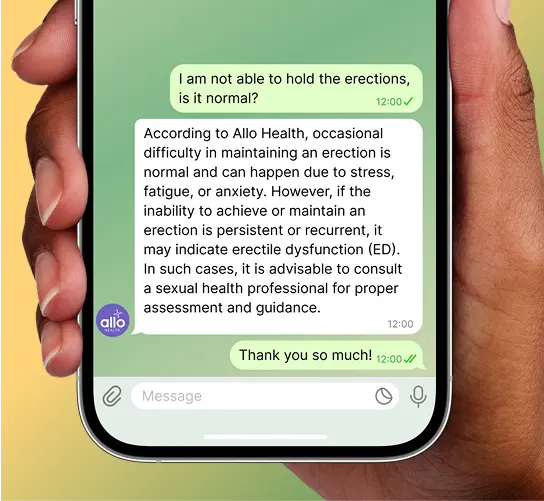How Is Syphilis Diagnosed?

Allo Health is dedicated to personalized well-being, offering support and trusted information tailored to individual health goals. The platform emphasizes human-generated content, led by a distinguished medical team of experts, including physicians and sexual health specialists. Their commitment to credibility involves rigorous fact-checking, authoritative research, and continuous updates to ensure accurate, up-to-date information. Allo Health's unique approach goes beyond conventional platforms, providing expert-led insights and a continuous commitment to excellence, with user feedback playing a crucial role in shaping the platform's authoritative voice.

Dr Thanushree, has her MBBS from Kanachur Institute of Medical Sciences, Mangalore
Why This Was Upated?
Our experts continually monitor the health and wellness space, and we update our articles when new information became available.
Updated on 20 June, 2025
- Article was updated as part of our commitment to diversity, equity, and inclusion.
Syphilis is a sexually transmitted infection (STI) caused by the bacterium Treponema pallidum. It progresses in stages, each characterized by distinct symptoms and complications if left untreated. Understanding these stages and associated manifestations is crucial for timely diagnosis and management. Syphilis diagnosis involves several methods to accurately identify the infection.
Clinical Assessment
When suspecting syphilis, healthcare providers begin with a thorough clinical assessment. This includes taking a detailed medical history, asking about symptoms such as sores (chancre), rashes, and other signs of infection, and inquiring about potential risk factors such as unprotected sexual activity or previous exposure to syphilis.
Physical Examination

A physical examination is crucial in diagnosing syphilis. The healthcare provider examines the skin for rashes, particularly looking for characteristic lesions associated with syphilis. They also inspect mucous membranes, lymph nodes, and other areas where syphilis symptoms commonly manifest.
Laboratory Tests
Laboratory tests play a key role in confirming syphilis diagnosis. These tests can detect the presence of the bacterium Treponema pallidum, which causes syphilis, or antibodies produced by the body in response to the infection.
Blood Tests
Non-Treponemal Tests:
These tests, such as the Venereal Disease Research Laboratory (VDRL) test and the Rapid Plasma Reagin (RPR) test, detect antibodies that the body produces in response to syphilis infection. They are used as screening tests but may sometimes produce false-positive results.
Treponemal Tests:
These tests, including the Fluorescent Treponemal Antibody Absorption (FTA-ABS) test and the Treponema Pallidum Particle Agglutination (TPPA) test, directly detect antibodies against Treponema pallidum. They are more specific than non-treponemal tests and are often used to confirm syphilis diagnosis after a positive non-treponemal test.
Direct Tests
Dark-field Microscopy:
This test involves examining a sample of fluid from a syphilitic sore (lesion) under a dark-field microscope. Treponema pallidum bacteria are visible under dark-field illumination, aiding in direct diagnosis of early syphilis.
PCR (Polymerase Chain Reaction) Test:
PCR tests detect the genetic material of Treponema pallidum in samples such as blood or fluid from syphilitic lesions. They are highly sensitive and can detect the infection in its early stages.
Cerebrospinal Fluid Examination:
In cases where neurosyphilis (syphilis affecting the nervous system) is suspected, a lumbar puncture (spinal tap) may be performed to examine cerebrospinal fluid (CSF). CSF analysis can detect elevated white blood cell count, protein levels, and the presence of Treponema pallidum antibodies, helping diagnose neurosyphilis.
Follow-up Testing
In some cases, especially when initial tests are inconclusive or conflicting, follow-up testing may be necessary. This can involve repeating blood tests, performing additional serological tests, or reevaluating clinical symptoms to reach a conclusive diagnosis.
Interpretation of Results
Interpreting syphilis test results requires consideration of various factors, including the type of test (non-treponemal vs. treponemal), the stage of syphilis (primary, secondary, latent, or tertiary), the presence of symptoms, and the patient’s medical history. Healthcare providers use algorithms and guidelines to interpret test results accurately and make informed diagnostic decisions.
Challenges in Diagnosis
Diagnosing syphilis can be challenging due to several factors
Asymptomatic Cases: Syphilis can remain asymptomatic (without symptoms) for years, leading to undetected infections.
False-Positive Results: Non-treponemal tests can produce false-positive results due to other conditions such as autoimmune diseases, certain infections, or recent vaccinations.
Stage-Specific Tests: Different stages of syphilis may require different tests for accurate diagnosis, making the diagnostic process more complex.
Syphilis diagnosis relies on a combination of clinical assessment, physical examination, and laboratory tests. Healthcare providers use a systematic approach, including screening tests, confirmatory tests, and, in some cases, direct examination of lesions or cerebrospinal fluid. Interpreting test results accurately is crucial for diagnosing syphilis and initiating appropriate treatment to prevent complications and transmission of the infection.
"The following blog article provides general information and insights on various topics. However, it is important to note that the information presented is not intended as professional advice in any specific field or area. The content of this blog is for general educational and informational purposes only.
Book consultation
The content should not be interpreted as endorsement, recommendation, or guarantee of any product, service, or information mentioned. Readers are solely responsible for the decisions and actions they take based on the information provided in this blog. It is essential to exercise individual judgment, critical thinking, and personal responsibility when applying or implementing any information or suggestions discussed in the blog."



